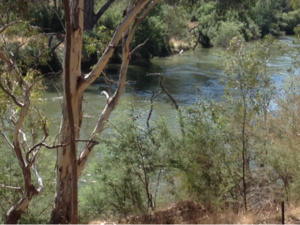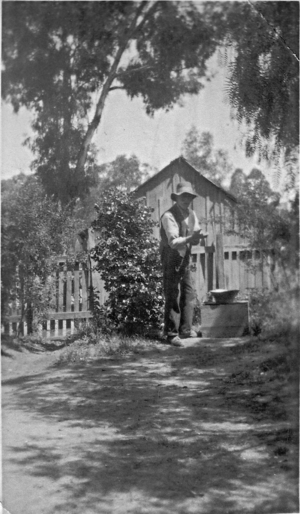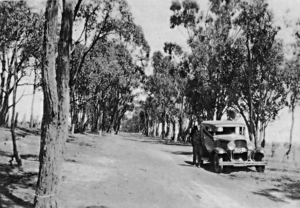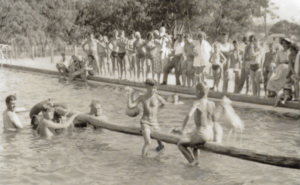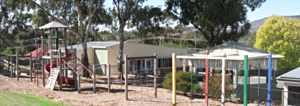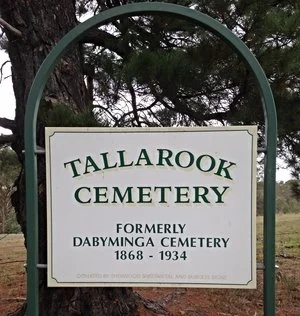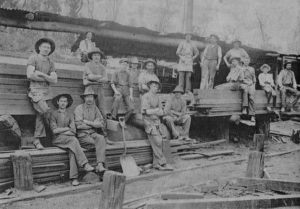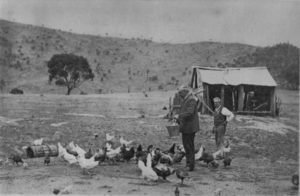The Origins Of Tallarook
Louis Buvelot completed his painting Between Tallarook and Yea in time for the 1880 Melbourne International Exhibition. American critic Sidney Dickinson described it several years later as "the most important landscape that has ever been produced with an Australian subject…The picture is unmistakably Australian, and combines in a high degree the best elements of realism and ideality". Between Tallarook and Yea won a Gold Medal at the International Exhibition and has been in the National Gallery of Victoria’s collection since Mr T.W. Stanford, its owner, donated it in 1902.[1]
The “unmistakably Australian” character that Dickenson saw in Buvelot’s painting may explain many of the stories associated with this place. Historically, the town has been in a position to reflect much of the ebb and flow of Australia’s European history. Buvelot’s painting has a bucolic and peaceful natural setting, yet some of the great drivers of economic growth in 19th century Victoria are clearly there – a farm in the distance on the right, the farmer transporting his wool to Melbourne, his destination the markets that would sell and ship it around the world. Alongside him, however, is a nearly dry creek bed in the foreground and low river behind, emblematic of the difficulties that repeatedly face rural Australia.
The same year Buvelot was painting, and in the springtime, the Kilmore Free Press’s correspondent for Tallarook was inspired to write “The Tallarook mountains are again becoming attractive. Many merry parties are organised to gamble over them to gather ferns and other floral treasures which are beginning to adorn their sides, with the ultimate object of reaching the summit, and there feast the vision on the picturesque scenes that lie beyond - the river meandering on through the green clad fields and thick foliaged gums, till reaching, as it were, the bright amber sky that is seen far away.”
At the time Buvelot’s farmer was making his way to Melbourne, Tallarook had a population of about 170 people and was on the cusp of what was probably its busiest time ever. The Tallarook district began life as a pastoral run south of the Goulburn River occupying the land between Sunday Creek and King Parrot Creek. It included the Dabyminga Creek and the Tallarook forest and had been acquired by Joseph Hawdon in 1838. In 1843 Hawdon sold off a small southern portion between the Sunday and Dabyminga Creeks, retaining 27,520 acres of Tallarook Station. Ten years later he again, and with little imagination, divided the station into the Tallarook Sheep Run and Tallarook. The sheep run was also between the Sunday and Dabyminga Creeks and included the Tallarook Flats. Tallarook ‘proper’ was the remaining land as far as King Parrot Creek to the east and included the Tallarook Homestead, later named and still known today known as Landscape. In 1856 Hawdon sold both Tallarooks to his brother-in-law Robert Outhwaite who later resold them, sub-dividing the larger one before he did so.[2]
As if Hawdon naming both sub-divisions Tallarook was not confusing enough, surveyor Thomas Pinniger drew a plan in August 1855 called the Township of Tallarook on the Goulburn River. This plan had the town on the northern side of the river and included a river crossing for traffic coming to and from Melbourne and Broadford in the south. This township of Tallarook, on the Goulburn River and in the Parish of Tallarook, was gazetted in 1855. Two years later Pinniger surveyed a telegraph route between Broadford and Avenel, running through this Tallarook. A handful of astute and determined businessmen living in Seymour were alert to the long-term ramifications of major road and communication routes just out of their reach, so travelled to Melbourne and lobbied the government to have the telegraph constructed along the old Sydney Road [Hume Freeway] through Seymour. This also meant the Goulburn River crossing would be moved from Tallarook to Seymour.
These gentlemen were successful and Tallarook “on the Goulburn River” never eventuated. However, use of the name Tallarook had become commonplace and was instead applied to the village that was evolving within the old Tallarook Station and near Tallarook House. Beginning with only a coach stables managed by brothers Thomas and William Fox on the road between Broadford and Seymour and the junction of the road leading to Yea, by 1867 there were nineteen ratepayers and their families, several bark, weatherboard, brick or slab cottages, three stores, a butchers, a post office, a bakehouse, two hotels, a public house, a blacksmiths, four stables and a coach stable.[3] So despite losing out on the Goulburn River crossing and the telegraph, Tallarook, both the name and the new position, was well and truly established in the 1860s. When surveyed in 1869 it was given the name of Dabyminga, the creek it sat alongside, but the name “Tallarook” had already stuck and was easier to say. The “new” Tallarook was not gazetted until 1952, and with the original one still officially listed there was a period of time when Victoria had two Tallarooks before the original one north of the river was rescinded.[4]
From the beginning the Fox brothers were key players in the development of this little village, owning land and providing many of the services required. Thomas had a store, a hotel and a post office, two properties south of Lodge Street and east of Main Road, all the property in the next block south, and another in the third block. William also had a store and a hotel north of Lodge Street, and a property in Hedley’s Lane off the Main Road.
Tallarook was a pastoral area but John Hedley, who had arrived in the 1850s, worked as a sawyer digging saw pits the depth of a man’s height and using a crosscut sawing method. The Hedleys remained in Tallarook working as blacksmiths, labourers, mail delivery and other jobs as well as having Hedley’s lane off Main Road opposite the primary school named after them.
Michael Hickey arrived in Sydney from Limerick in Ireland on the ship Adam Lodge in 1839. He was 14 years old and the next day managed to get a job with Jamieson Bros assisting to move sheep and cattle all the way to Tallarook Station some 500 miles [800km] away. Michael remained at the station working for the Jamieson brothers and then for Joseph Hawdon when he took over. When Michael got married he and his new bride received a wedding present from Joseph Hawdon of 160 acres within the Station property. Michel built a house and named it Camp Hill. He had good relationships with the Taungurung locals who camped on the hill overlooking Hickey’s property and so Michael named his place for them. The story goes that a high and very fast moving flood one year made it extremely dangerous for Michael and his family to swim to safety but the Taungurung rescued them using canoes.
Hickey’s life appears to have been consumed with local matters. He was a founder or member of the local cricket, football and tennis clubs, an advocate for community matters through his membership of the Road Board, the Shire Council and his role as a Justice of the Peace, amongst other positions. When he died at the age of 83 from senile decay, having been blind with cataracts for 11 years, Tallarookians were truly saddened so that “from far and near they assembled at very short notice and the mournful procession was one of the largest seen in the district.” [5]
During the 1880s the town grew and many more families established themselves, some for many generations and who still live there today. More shops, businesses, services, sporting teams and community activities were established to sustain the lives of these Tallarookians. A small wooden Catholic church was built in 1864 before the foundations of a stone church were laid in 1865, although that building seemed to take over twenty years to complete as it was finally opened by Archbishop Carr in 1887. An Anglican church was built in 1884.
Tallarook School #745 opened in 1864 on Catholic church land with twenty-eight children enrolled for the following year. Number 745 contented to operate until the end of 1874, by which time education had become free, compulsory and secular in Victoria for two years and a new brick building 36’ by 20’ had been built on a site gazetted for a state school. Head Teacher Michael Cussen and School Workmistress Ellen Condon took their positions with them to the new Tallarook State School #1488, along with 126 students newly enrolled. Secular and free may have been embraced by families enrolling their children, but at a time when children were still required to help out at home and on the farm, compulsory attendance was rarely embraced. The average attendance that first year was 61, a high compared to the following early years of the school when attendance could drop as low as 20. These days Tallarook State School #1488 has both an enrolment and an attendance of around 80 students.
On 5 May 1870 a Kilmore Free Press correspondent wrote “We are glad to notice that our advocacy of procuring more police protection for the Sydney line of road has not been futile. An extra constable has been placed at each of the following stations, viz Broadford, Avenel and Longford. If there is one place where a constable or two should be stationed we think it is Tallarook, and we are sorry the peaceable inhabitants of that place have not had a guardian of the peace appointed to watch over them. Perhaps it may soon be remedied.” This was a particular problem at the time when the notorious bushranger Henry Power, having escaped from Pentridge the previous year, was holding up mail coaches and committing, he later claimed for himself, over 600 robberies across the district. For a short while a 13-year-old local boy called Ned Kelly provided assistance, and he showed great bushranging promise, but in the end a Kelly family associate provided the police with the information they needed to capture Power in June 1870.[6] Press reports telling of a police officer stationed in Tallarook in February 1871 indicate the Kilmore Free Press’s persistent advocacy for a police station was effective. The station remained for over a hundred years until it was closed to become part of the wider Seymour Police sub-district in 1989.
The Tallarook Cemetery had ten acres gazetted for it in 1871, although by then many locals had been buried in a nearby but unofficial cemetery or on family farms or behind the Catholic church, as well as in cemeteries at Seymour, Kilmore and other nearby towns. The post office was initially at William Fox's Hotel before being moved to the railway station in the 1870s, and back to the Main Road next to the Junction Hotel. Then the railway arrived in 1872 providing a boost to the local timber industry and more employment for those living nearby. John Hedley no longer had to clamber down into a saw pit to cut logs as two mills were established near the station, providing ready transport to Melbourne. A second line was built to Yea, opening in 1883.[7]
Because the railway was considered “a matter of the greatest importance to the inhabitants of the Goulburn Valley” the Alexandra Times explored the district in April 1872 to assess the impact and effects of this impending great change. When they reached Tallarook they found it to be “by no means a busy or interesting place. It consists of two hotels, two stores, two blacksmiths’ forges, a police station, and a number of tumble-down, miserable-looking huts of slabs and bark. The inhabitants generally are a very slow class of individuals of the older times, who allow events to come and go without any interference on their part. The Railway Hotel is a substantial, good brick building, and should the traffic of the Goulburn flow towards Tallarook will be a valuable property, as it is situated nearly opposite the proposed station. The proprietor, in the mean time, intends to run a conveyance from his house to Schoolhouse Lane to meet the up and down trains. With [this] exception the Tallarookites seem not to know or care much about the traffic of the upper Goulburn... The Yea Board have selected the road, and are determined to carry it through, independently of the indifference of the inhabitants of Tallarook, all of whom will be greatly benefitted by it.”[8]
While Tallarook appeared to outsiders to be an insular town, and many of its inhabitants certainly were “of the older times” being some of the first explorers and settlers in the wider district, they had worked hard to nourish a community. Their failure to secure the Goulburn River crossing and the telegraph from the hands of the Seymour businessmen some fifteen or so years earlier may have been due to a similar lack of hutzpah the Alexandra Times had found irritating, but expansion was never their game. Settlement and community was, and by 1890 Tallarook had just about everything it needed bar one of the characteristic components of most 19th century communities - a mechanics institute and free library.
Niall Brennan, New Crossing Place. A History of Seymour and its Shire; Lorraine Huddle Pty Ltd, Shire of Mitchell Heritage Study Stage Two, 2006, Volume 5
Huddle, ibid
Huddle, ibid; Brennan, ibid
"Dabyminga, Tallarook" notes provided by Brian Outhwaite; "Extended list of burials in the Dabyminga (Tallarook) public cemetery c1864-2004"
Huddle. ibid; "Extended list of burials..."; history of primary school Tallarook 1488. 1864-2000, John Jennings
Alexandra Times, 26 April 1872, p.2 ‘Tallarook’.


